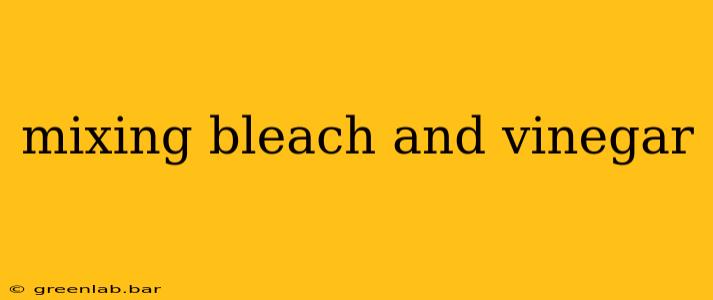Mixing bleach and vinegar might seem like a harmless household chore, especially given their common use in cleaning. However, this seemingly innocuous combination can produce dangerous and potentially life-threatening gases. This article delves into the chemical reaction, the health risks, and safer alternatives for cleaning your home.
The Science Behind the Danger
Bleach, primarily sodium hypochlorite (NaClO), is a powerful oxidizing agent. Vinegar, primarily acetic acid (CH₃COOH), is a weak acid. When these two are combined, they don't simply mix; they react. This reaction produces chlorine gas (Cl₂), a highly toxic and potentially lethal substance.
Understanding the Chemical Reaction
The reaction between bleach and vinegar isn't a simple addition; it's a chemical transformation. The acetic acid in vinegar reacts with the hypochlorite ion in bleach, liberating chlorine gas. This isn't a slow, gradual process; the reaction happens relatively quickly, releasing the gas into the air.
The equation, while simplified, illustrates the basic principle:
NaClO (bleach) + CH₃COOH (vinegar) → Cl₂ (chlorine gas) + other products
The "other products" include various compounds, but the primary concern remains the release of chlorine gas.
Health Risks Associated with Chlorine Gas Exposure
Inhaling chlorine gas can cause a range of health problems, from mild irritation to severe respiratory distress, depending on the concentration and duration of exposure. Symptoms can include:
- Eye irritation: Burning, stinging, and tearing.
- Respiratory irritation: Coughing, shortness of breath, wheezing, and chest tightness.
- Skin irritation: Redness, itching, and burning.
- Nausea and vomiting: In more severe cases.
- Severe lung damage: In cases of high concentration or prolonged exposure. This can lead to pneumonia or even death.
Safer Cleaning Alternatives
There's absolutely no reason to mix bleach and vinegar. Both are effective cleaning agents on their own, and using them separately is far safer. Consider these alternatives:
Using Bleach Safely:
- Always dilute bleach according to the manufacturer's instructions. Never mix it with other cleaning products, especially ammonia or acids.
- Ensure adequate ventilation when using bleach. Open windows and doors to allow fresh air circulation.
- Wear protective gloves and eye protection to avoid skin and eye contact.
- Never ingest bleach. If ingestion occurs, seek immediate medical attention.
Using Vinegar Safely:
- Vinegar is a natural disinfectant effective against many bacteria and viruses. It's a particularly good choice for cleaning surfaces like countertops and cutting boards.
- Dilute vinegar with water for most cleaning tasks. A 50/50 solution is often sufficient.
- Use vinegar cautiously on delicate surfaces, as it can be corrosive to some materials. Always test a small, inconspicuous area first.
Other Effective Cleaning Options:
Explore other cleaning options, such as baking soda, hydrogen peroxide, or commercially available, environmentally friendly cleaning products specifically designed for various surfaces and cleaning needs. These options offer effective cleaning power without the inherent dangers of mixing bleach and vinegar.
Conclusion: Prioritize Safety
Mixing bleach and vinegar is a dangerous practice with potentially severe health consequences. The release of chlorine gas presents a significant risk to respiratory health and overall well-being. Always prioritize safety and use cleaning agents separately and according to their respective instructions. Remember, effective cleaning doesn't require risky chemical combinations. Numerous safer and equally effective alternatives are readily available.

